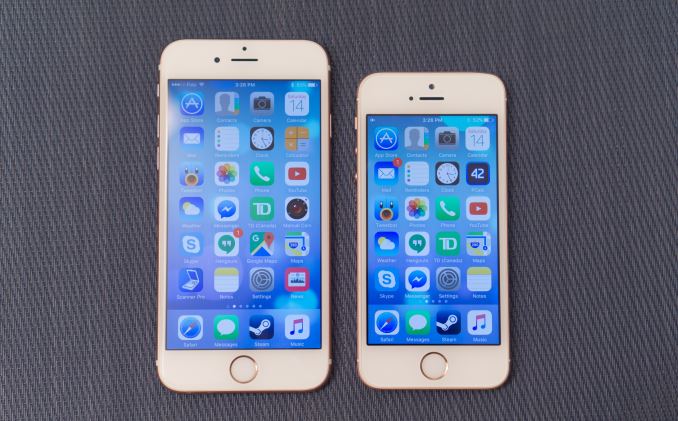The iPhone SE Review
by Brandon Chester on May 16, 2016 8:00 AM EST- Posted in
- Smartphones
- Apple
- Mobile
- iPhone
- iPhone SE
Going Back To A 4-Inch Smartphone
The Android world left the 4-inch smartphone behind long ago. While Apple was still playing the 3.5-inch smartphone game, Android phones moved from 4 inches, to 4.3 inches, to 4.5 inches, and so on. Nowadays, your standard Android flagship phone has a display that is a little over five inches in size, and a 4.5-inch display is what’s considered a tiny phone. Of course, there are other factors related to device size like whether you have physical or on-screen buttons and how large your bezel is, but the screen size is still what defines the limits of your window into the internet and all your applications. A couple of years ago I used the iPhone 5s, and nowadays I use the Nexus 5X and the iPhone 6s. Devices that really bring total device size up a notch like the Galaxy Note 5 and iPhone 6s Plus are simply far too large for me to use comfortably. Even with that, going back to a 4-inch smartphone definitely takes time to get used to, and it’s given me some interesting insights into what you gain and what you lose by moving to a larger device.
My first point about the iPhone SE seems patently obvious, but it’s really worth stating that when you move from a 5-inch smartphone to a 4-inch one it really feels small. I’ve actually been having some interesting thoughts on this subject as I’ve juggled between various iPads for the upcoming 9.7-inch iPad Pro review. If you use the iPad Mini for a long time, a 9.7-inch iPad feels absolutely enormous by comparison. Similarly, when you use the 12.9-inch iPad Pro for a long time, the 9.7-inch iPad feels like an iPad Mini in comparison, and the Mini itself feels absurdly small. In all these cases there’s an adjustment period where one has to get used to the size of the device, and after that time passes it becomes your reference point for what is normal.
I don’t expect that too many users will actually go through this adjustment period if they buy the iPhone SE, as I would imagine that many prospective buyers are people who are still holding on to their iPhone 5 or 5s and have been hoping for an updated 4-inch iPhone. After getting used to the SE, I’ve found myself enjoying the one-handed usability. Say what you will about features like reachability and one-handed modes; the 4-inch screen is simply much easier to use with one hand. I never worry about dropping the phone, and I don’t find myself having to shift my hand to reach the upper left area of the display.
On the flip side, the 4-inch form can feel quite cramped, even after adjusting to the smaller display size. With the default settings the information density is absolutely laughable, and I can’t use the phone without the text size setting set to the smallest value. I use the smallest text size on all my devices, but for users who need a larger font due to aging eyes I would honestly rule out the iPhone SE immediately unless you’re comfortable with doing a lot of scrolling. Even with that changed, you simply can’t fit near as much on the screen. You get one fewer row of home screen icons, fewer emails in the Mail app, no avatars in the Messages app, and similar reductions throughout the rest of Apple’s apps as well as third party ones. Features like Control Center which just goes past the halfway point on the 6s takes up nearly the entire screen, and it makes me wonder how it ever even fit on the 3.5-inch iPhones.
All of these changes are just a function of the display size, and while they seem obvious, it’s difficult to understand the extent to which they change the experience of using the phone. While I’m not someone who is sold on phablets, I certainly see the value in them for many people, and for me the sweet spot is something in the 4.5 to 4.7-inch range. I’ve used the iPhone SE as my primary device for a month now to see how it works for me, and when I returned to the Nexus 5X and iPhone 6s they both felt absolutely enormous. However, I find myself really valuing the additional information that I can see in the larger display while still having the phones be relatively usable with a single hand. The 4-inch screen isn’t the right size for me, but I recognize the benefits of it. With Apple having sold 30 million 4-inch smartphones last year despite the fact that their offering was a phone from 2013, there’s clearly a market for such a device, and I think the iPhone SE will make those users quite happy.













138 Comments
View All Comments
michael2k - Monday, May 16, 2016 - link
You're curious how much faster the iPhone SE is than the Galaxy S7? Just look for iPhone 6S and you'll see, given the SE uses the same SoC as the 6S:http://www.anandtech.com/show/10120/the-samsung-ga...
osxandwindows - Monday, May 16, 2016 - link
I can't wait for the "anandtech is so biased" comments to show up.Alexey291 - Monday, May 16, 2016 - link
Ah yes the first of the flame bait comment, so soon too...That said I did giggle at the excuse that he can't use non review data in a review. I'm pretty sure I've seen that happen far more than once. But yeah whatever. It's just a phone
extide - Tuesday, May 17, 2016 - link
That's not what he said. He said he can't use data that he doesnt have.xmrv - Sunday, May 22, 2016 - link
sheeps dont do that so you wont see any comments like that on this site...DesertCat - Monday, May 16, 2016 - link
Thanks for the article. I have some friends wanting to stick with the smaller form factor and will forward your review along.One quibble from the Experience page: "X fewer emails in the Mail app"
I'm guessing that was a place holder waiting for you to update with the number after you looked it up. May want to get that edit in. ;)
MonkeyPaw - Monday, May 16, 2016 - link
It's a little bit of a lazy effort from Apple, but it should still be a crowd pleaser. The issue is that you can get a much bigger display in the footprint of the SE. I believe the Xperia Compact is almost the same size as the SE, but can offer a 4.6" display instead. That big thumb button is really costly on Apple devices.Aenean144 - Monday, May 16, 2016 - link
No, it really isn't. The Touch ID home button has been a huge advantage, well worth the costs of poorer screen-to-body ratios. Maybe in the future the button goes away, but it has served Apple and Samsung quite well.iPhone 5/5S/SE
dimensions: 12.4 x 5.9 x 0.76 cm
footprint: 73.2 cm^2
volume: 55.6 cm^3
Xperia Z5 compact
dimensions: 12.7 x 6.5 x 0.89 cm
footprint: 82.6 cm^2
volume: 73.5 cm^3
Xperia Z3 Compact
dimensions: 12.7 x 6.5 x 0.86 cm
footprint: 82.6 cm^2
volume: 71.0 cm^3
iPhone 6
dimensions: 13.8 x 6.7 x 0.69 cm
footprint: 92.5 cm^2
volume: 59.2 cm^3
iPhone 6S
dimensions: 13.8 x 6.7 x 0.71 cm
footprint: 92.5 cm^2
volume: 60.9 cm^3
The footprint of the Xperia "Compacts" are indeed small, but both the iPhone 5 and 6 models are smaller then them in there own ways. 5/5S/SE are smaller by 10% in footprint and 25% in volume. The iPhone 6/6S have smaller volumes by 15%.
An iPhone SE will definitely feel smaller than the Xperia Compacts, while the 6/6S may feel smaller then them depending on users favoring the thinnes. The Xperias also have onscreen home, back, multitasking keys, so that 4.6" has something like 4.2" of application space for many apps.
mooncancook - Monday, May 16, 2016 - link
Partially true regarding onscreen home/back keys. On lots of apps they auto hide so the app can use the entire screen, and you swipe that area to bring the keys up.ianmills - Monday, May 16, 2016 - link
Chinese phones put the touch ID just under the camera lense. It works great (at least on bigger phones) because thats where your finger naturally rests